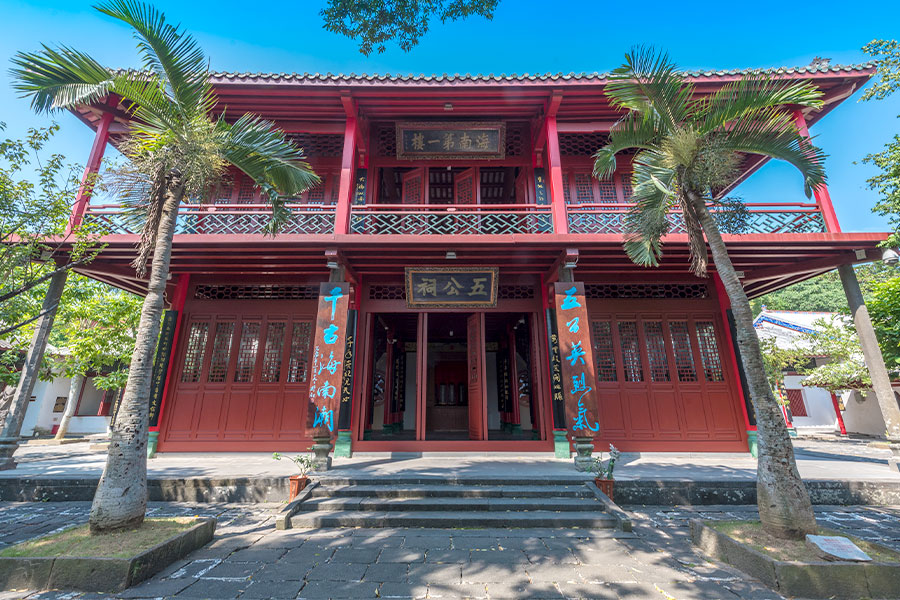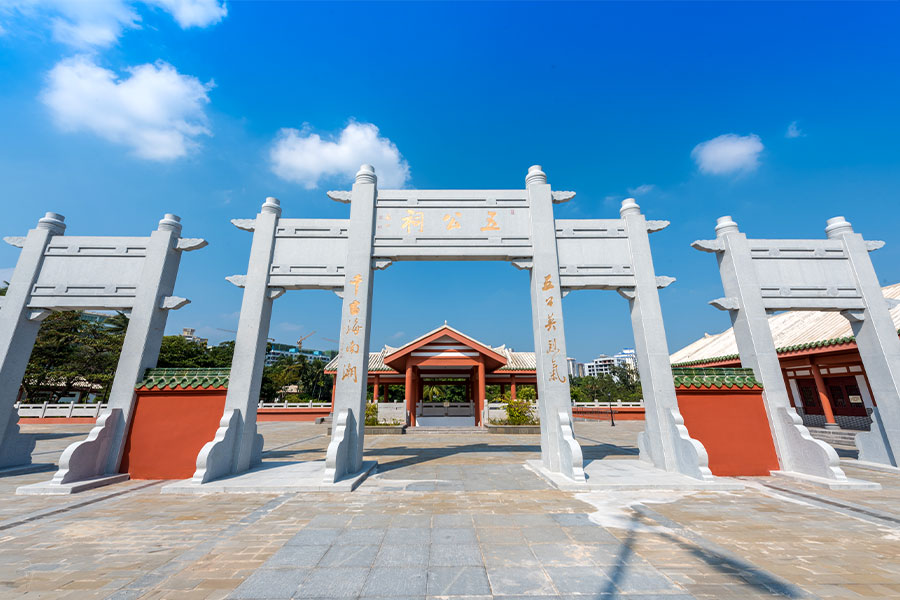Temple of Five Lords

Chinese name: 五公祠(Wu Gong Ci)
Location: No.169 Haifu Road, Qiongshan District, Haikou, Hainan Province, China
Opening time: 08:00 - 17:30
How to get there: Take buses No. 1, 4, 11, 37, 38, 41, 44, 45 to Temple of Five Lords Station.
Best time for visit: all year round
Recommended time for a visit: 2-3 hours
Introduction to Temple of Five Lords
Wu Gong Ci, or the Temple of Five Lords, located at the southeast of Haikou City, covering an area of about 66,000 square meters, is a comprehensive tourist scenic spot integrated with ancient buildings, historical sites and gardens. It was originally constructed during the reign of Emperor Wanli in the Ming Dynasty (1368-1644) and was renovated on several occasions during the Qing Dynasty (1644-1911). Now, it is a place known for its sense of peace, tranquility and beauty.

History and construction of Temple of Five Lords
In 1889, the local official of Qing Dynasty constructed the First Temple of Hainan as a memorial to the Five Lords, hence the name of The Five-Lord Temple. Actually it refers to the main building of the First Temple of Hainan and a group of ancient Chinese buildings around it. The main hall houses the vivid and lifelike stone statues of the five prestigious officials. On the inner pillars, there are two much praised couplets which visitors, having learnt about the background of the five officials, cannot help but admire. Additionally, a stone tablet that is carved with calligraphy inscriptions of Emperor Huizong, from the Song Dynasty, is also displayed in the temple.
The Five Lords Ancestral Hall is the main part of this building complex and is considered to be "the No.1 Building in Hainan" even though it is only a two-storied wooden building. This was constructed to commemorate the five famous officials- Li Deyu, Li Gang, Zhao Ding, Li Guang and Hu Quan who were banished to Hainan during the Tang Dynasty (618-907) and the Song Dynasty (960-1279). The main hall houses the vivid and lifelike stone statues of the five prestigious officials. On the inner pillars, there are two much praised couplets which visitors, having learnt about the background of the five officials, cannot help but admire. Additionally, a stone tablet that is carved with calligraphy inscriptions of Emperor Huizong, from the Song Dynasty, is also displayed in the temple.
Five officials
'The Five Lords' refer to the five famous officials in the Tang and Song Dynasties who were suppressed and sent into exile on Hainan. They are Li Deyu, prime minister of the Tang Dynasty, Li Gang, prime ministers of the Song Dynasty, Li Guang and Hu Quan, the great scholars of the Song Dynasty. Although the periods of time the Five Lords lived on the island were not the same, they were all best-known as being patriotic officials and national heroes, and were deeply remembered by the people of Hainan for their propagation of advanced culture of Central China and their influence on the development of Hainan's civilization.
Li Deyu (787-850)
Li Deyu (李德裕) served as chancellor during the Tang Dynasty. He was the leader and namesake of the Li faction during the Niu-Li Factional Struggles that pitted officials of humble and aristocratic origins against each other. Tang Emperor Xuanzong ended the struggles by handing complete defeat to the Li faction, demoting Li Deyu and sending him to exile in Hainan, where he held the position of census officer at Yai Prefecture (modern Haikou) and remained until his death.
Li Gang (1083-1140)
Li Gang (李纲) was a government official who held the office of chancellor for a brief period (75 days) during final days of the Northern Song Dynasty. He was put in charge of the defense against the invading Jin dynasty by the young Emperor Qinzong during the Jin-Song wars, but was removed from his post when the emperor was falsely hoping to enter peace negotiations with the Jin. The Northern Song Dynasty fell in 1127 and Emperor Qinzong became a prisoner of the Jin dynasty for the rest of his life. Li Gang was released from exile and rehabilitated in 1129 and held various government offices in the Southern Song Dynasty.
Li Guang (1078-1159)
Li Guang (李光) was exiled to Qiongzhou (now Haikou) in Hainan in 1144.
Zhao Ding (1085-1147)
Zhao Ding (赵鼎) was a statesman and renowned poet of the Southern Song Dynasty. He advocated attempts to recover territory lost to the Jin dynasty and committed suicide dying as a result of a hunger strike.
Hu Quan (1102-1180)
Hu Quan (胡铨).
Quick Questions
Our team is waiting for your questions. Please feel free to ask us any questions you might have about our China package tours, Chinese culture, or the sites available. We will gladly help you with any special needs you might have and all questions, like our trip designing is completely free of charge.




